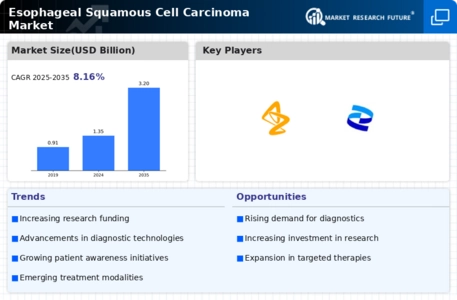Advancements in Treatment Modalities
Recent advancements in treatment modalities for esophageal squamous cell carcinoma are significantly influencing the Esophageal Squamous Cell Carcinoma Market. Innovations in surgical techniques, radiation therapy, and chemotherapy have improved patient outcomes and survival rates. The introduction of targeted therapies and immunotherapies has also transformed the treatment landscape, offering new hope to patients. Market data indicates that the adoption of these advanced therapies is on the rise, with a projected increase in market share for companies developing novel treatment options. Furthermore, ongoing clinical trials are exploring combination therapies that may enhance efficacy. As these advancements continue to emerge, they are expected to drive the growth of the Esophageal Squamous Cell Carcinoma Market, attracting investments and fostering competition among key players.
Investment in Research and Development
Investment in research and development is a significant driver for the Esophageal Squamous Cell Carcinoma Market. Pharmaceutical companies and research institutions are increasingly allocating resources to explore novel therapeutic agents and improve existing treatment protocols. This focus on R&D is driven by the urgent need for more effective therapies, particularly for advanced stages of the disease. Market analysis indicates that the R&D expenditure in oncology, including esophageal squamous cell carcinoma, is projected to increase substantially in the coming years. This investment not only fosters innovation but also enhances collaboration between academia and industry, leading to the development of cutting-edge solutions. As a result, the Esophageal Squamous Cell Carcinoma Market is likely to witness a surge in new product launches and treatment options, catering to the evolving needs of patients.
Growing Awareness and Screening Programs
The growing awareness of esophageal squamous cell carcinoma and the implementation of screening programs are crucial drivers for the Esophageal Squamous Cell Carcinoma Market. Educational initiatives aimed at both healthcare professionals and the general public have led to increased recognition of the disease's symptoms and risk factors. Consequently, more individuals are seeking medical advice and undergoing diagnostic procedures. Data suggests that regions with established screening programs have reported earlier detection rates, which are associated with improved treatment outcomes. This trend is likely to encourage further investment in diagnostic technologies and therapeutic solutions within the Esophageal Squamous Cell Carcinoma Market. As awareness continues to rise, the demand for effective screening and treatment options is expected to grow, thereby enhancing market dynamics.
Regulatory Support and Approval Processes
Regulatory support and streamlined approval processes are emerging as vital drivers for the Esophageal Squamous Cell Carcinoma Market. Regulatory agencies are increasingly recognizing the need for expedited pathways for innovative therapies, particularly in oncology. This shift is aimed at addressing the urgent medical needs of patients suffering from esophageal squamous cell carcinoma. Recent initiatives have led to faster review times and approvals for new drugs and treatment modalities, thereby facilitating quicker access to potentially life-saving therapies. Market data suggests that this regulatory environment is conducive to fostering innovation and encouraging investment in the Esophageal Squamous Cell Carcinoma Market. As regulatory frameworks continue to evolve, they are likely to enhance the overall market landscape, promoting the development and availability of effective treatment options.
Increasing Incidence of Esophageal Squamous Cell Carcinoma
The rising incidence of esophageal squamous cell carcinoma is a pivotal driver for the Esophageal Squamous Cell Carcinoma Market. Factors such as lifestyle changes, dietary habits, and increased tobacco and alcohol consumption contribute to this trend. According to recent data, the incidence rates have shown a notable increase in certain regions, particularly in Asia and parts of Africa. This surge in cases necessitates enhanced diagnostic and therapeutic options, thereby propelling market growth. The growing awareness among healthcare professionals and patients regarding the disease's prevalence further emphasizes the need for effective treatment modalities. As the population ages, the demand for innovative solutions in the Esophageal Squamous Cell Carcinoma Market is likely to escalate, creating opportunities for pharmaceutical companies and healthcare providers alike.


















Leave a Comment